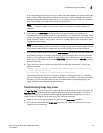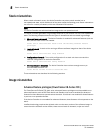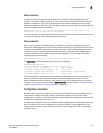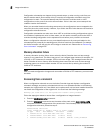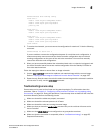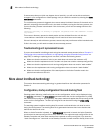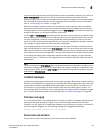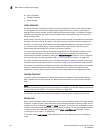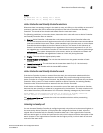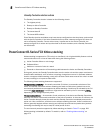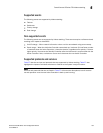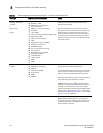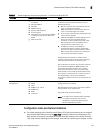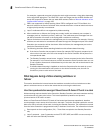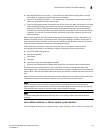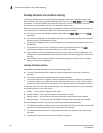
PowerConnect B-Series FCX Configuration Guide 161
53-1002266-01
More about IronStack technology
5
Example
My stack unit ID = 1, bootup role = active
My stack unit ID = 3, bootup role = standby
Active Controller and Standby Controller elections
Whenever there is a topology change in the stack (a reset, unit failure, or the addition or removal of
members), elections are held to determine the status of the Active Controller and Standby
Controller. The results of the election take effect after the next stack reset.
The following conditions, in the order shown, determine which units will serve as Active Controller
and Standby Controller after an election:
• Boot as Active Controller - Indicates that a unit was previously Active Controller before the
current boot sequence and will again assume the role of Active Controller when two standalone
units are combined into a stack. When a third standalone unit joins the stack, a current Active
Controller becomes subject to the other factors in this list. The reason for this hierarchy of
factors is to achieve a predictable winner regardless of the boot up sequence for a unit. You
can upgrade your current Active Controller to “boot as active controller” status by performing a
write memory. The system interprets the write memory action as a directive to maintain the
current Active Controller role regardless of resets or a new unit joining the stack.
• Priority - The unit with the highest priority value.
• Greater number of members - The unit that has control over the greater number of stack
members.
• Lowest boot stack ID - The unit that has the lowest boot stack ID (1-8, 1 is the lowest).
• MAC address - The member with the lowest MAC address.
Active Controller and Standby Controller resets
If the Active Controller is reset or removed from the stack, the entire stack reloads and Active
Controller and Standby Controller elections are initiated. If the unit functioning as the previous
Active Controller is no longer part of the stack, the Standby Controller unit becomes the new Active
Controller. After a reset, if no stack member qualifies as Active Controller, the existing Standby
Controller waits 30 seconds and then assumes the role of Active Controller.
If both Active and Standby Controllers are removed the rest of the stack will continue to function
because they are operating on whatever is programmed in the hardware. The stack members will
not be able to learn any new addresses. You will see the following message every few minutes.
Stack member is non-operational because of no Active or Standby Controller
You can recover to standalone mode by “stack unconfigure me”
Use stack unconfigure me to restore the units into standalone devices with a pre-stacking
configuration.
Selecting a standby unit
You can choose a Standby Controller by configuring a stack unit priority to be the second highest, or
the same as the Active Controller. If the priorities are configured the same for both, when the
original Active Controller fails, the Standby Controller takes over. If the original Active Controller
becomes active again, it will not win back its active role, which helps to minimize interruption of the
stack. However, if the original Active Controller has the higher priority, it will win back its role and
reset all of the stack units.



